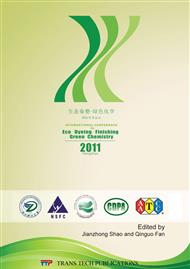p.726
p.731
p.736
p.741
p.746
p.750
p.754
p.759
p.764
Effect of Cellulase Enzyme Treatment on the Pulp Beatability and Fiber Properties
Abstract:
The focus of this study is to investigate the effect of cellulase enzyme treatment of the pulp on the reduction of energy consumption and the physical strength of old corrugated containers (OCC) fibers. Different cellulase samples including Novozyme Fibercare R, Novozyme Fibercare U and Novozyme Fibercare D used to improve the pulp beatability and physical strength of OCC fibers were comparatively studied. The effects of different cellulase samples on the breaking length and bursting index of paper were investigated. It was shown that Novozyme Fibercare D was proved to be the suitable cellulase sample used in the pretreatment of OCC fibers. It could become possible that the energy consumption of pulp beating reduced by 33.3% and the breaking length and bursting index of paper sheets increased by 50% when OCC fibers were dealt with Novozyme Fibercare D.
Info:
Periodical:
Pages:
746-749
Citation:
Online since:
January 2012
Authors:
Keywords:
Price:
Сopyright:
© 2012 Trans Tech Publications Ltd. All Rights Reserved
Share:
Citation:


